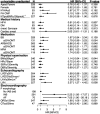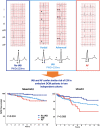Interatrial Block Predicts Life-Threatening Arrhythmias in Dilated Cardiomyopathy
- PMID: 35861818
- PMCID: PMC9707810
- DOI: 10.1161/JAHA.121.025473
Interatrial Block Predicts Life-Threatening Arrhythmias in Dilated Cardiomyopathy
Abstract
Background Interatrial block (IAB) has been associated with supraventricular arrhythmias and stroke, and even with sudden cardiac death in the general population. Whether IAB is associated with life-threatening arrhythmias (LTA) and sudden cardiac death in dilated cardiomyopathy (DCM) remains unknown. This study aimed to determine the association between IAB and LTA in ambulant patients with DCM. Methods and Results A derivation cohort (Maastricht Dilated Cardiomyopathy Registry; N=469) and an external validation cohort (Utrecht Cardiomyopathy Cohort; N=321) were used for this study. The presence of IAB (P-wave duration>120 milliseconds) or atrial fibrillation (AF) was determined using digital calipers by physicians blinded to the study data. In the derivation cohort, IAB and AF were present in 291 (62%) and 70 (15%) patients with DCM, respectively. LTA (defined as sudden cardiac death, justified shock from implantable cardioverter-defibrillator or anti-tachypacing, or hemodynamic unstable ventricular fibrillation/tachycardia) occurred in 49 patients (3 with no IAB, 35 with IAB, and 11 patients with AF, respectively; median follow-up, 4.4 years [2.1; 7.4]). The LTA-free survival distribution significantly differed between IAB or AF versus no IAB (both P<0.01), but not between IAB versus AF (P=0.999). This association remained statistically significant in the multivariable model (IAB: HR, 4.8 (1.4-16.1), P=0.013; AF: HR, 6.4 (1.7-24.0), P=0.007). In the external validation cohort, the survival distribution was also significantly worse for IAB or AF versus no IAB (P=0.037; P=0.005), but not for IAB versus AF (P=0.836). Conclusions IAB is an easy to assess, widely applicable marker associated with LTA in DCM. IAB and AF seem to confer similar risk of LTA. Further research on IAB in DCM, and on the management of IAB in DCM is warranted.
Keywords: dilated cardiomyopathy; electrocardiography; interatrial block; life‐threatening arrhythmias; non‐ischemic cardiomyopathy; sudden cardiac death.
Figures






Similar articles
-
Interatrial block and interatrial septal thickness in patients with paroxysmal atrial fibrillation undergoing catheter ablation: Long-term follow-up study.Ann Noninvasive Electrocardiol. 2017 Jul;22(4):e12428. doi: 10.1111/anec.12428. Epub 2016 Dec 25. Ann Noninvasive Electrocardiol. 2017. PMID: 28019054 Free PMC article.
-
Interatrial Block Association With Adverse Cardiovascular Outcomes in Patients Without a History of Atrial Fibrillation.JACC Clin Electrophysiol. 2023 Aug;9(8 Pt 3):1804-1815. doi: 10.1016/j.jacep.2023.04.006. Epub 2023 Jun 21. JACC Clin Electrophysiol. 2023. PMID: 37354170
-
Advanced interatrial block predicts new-onset atrial fibrillation and ischemic stroke in patients with heart failure: The "Bayes' Syndrome-HF" study.Int J Cardiol. 2018 Nov 15;271:174-180. doi: 10.1016/j.ijcard.2018.05.050. Epub 2018 May 18. Int J Cardiol. 2018. PMID: 29801761
-
What every clinician should know about Bayés syndrome.Rev Esp Cardiol (Engl Ed). 2020 Sep;73(9):758-762. doi: 10.1016/j.rec.2020.04.026. Epub 2020 Jul 16. Rev Esp Cardiol (Engl Ed). 2020. PMID: 32684442 Review. English, Spanish.
-
Relation of Advanced Interatrial Block to Risk of Atrial Fibrillation and Stroke.Am J Cardiol. 2020 Jun 1;125(11):1745-1748. doi: 10.1016/j.amjcard.2020.02.034. Epub 2020 Mar 16. Am J Cardiol. 2020. PMID: 32284175 Review.
Cited by
-
A silent interweaving: interatrial block and laminopathy.Eur Heart J Case Rep. 2023 Dec 13;7(12):ytad616. doi: 10.1093/ehjcr/ytad616. eCollection 2023 Dec. Eur Heart J Case Rep. 2023. PMID: 38130858 Free PMC article. No abstract available.
-
Interatrial Block, Bayés Syndrome, Left Atrial Enlargement, and Atrial Failure.J Clin Med. 2023 Nov 26;12(23):7331. doi: 10.3390/jcm12237331. J Clin Med. 2023. PMID: 38068382 Free PMC article. Review.
-
Inter-atrial block as a predictor of adverse outcomes in patients with HFpEF.ESC Heart Fail. 2025 Jun;12(3):2287-2297. doi: 10.1002/ehf2.15179. Epub 2024 Dec 1. ESC Heart Fail. 2025. PMID: 39618165 Free PMC article.
-
[New atypical advanced interatrial block with triphasic morphology].Arch Peru Cardiol Cir Cardiovasc. 2025 Feb 12;6(1):60-62. doi: 10.47487/apcyccv.v6i1.476. eCollection 2025 Jan-Mar. Arch Peru Cardiol Cir Cardiovasc. 2025. PMID: 40376130 Free PMC article. Spanish. No abstract available.
-
Identification of BMP10 as a Novel Gene Contributing to Dilated Cardiomyopathy.Diagnostics (Basel). 2023 Jan 9;13(2):242. doi: 10.3390/diagnostics13020242. Diagnostics (Basel). 2023. PMID: 36673052 Free PMC article.
References
-
- Pinto YM, Elliott PM, Arbustini E, Adler Y, Anastasakis A, Böhm M, Duboc D, Gimeno J, de Groote P, Imazio M, et al. Proposal for a revised definition of dilated cardiomyopathy, hypokinetic non‐dilated cardiomyopathy, and its implications for clinical practice: a position statement of the ESC working group on myocardial and pericardial diseases. Eur Heart J. 2016;37:1850–1858. doi: 10.1093/eurheartj/ehv727 - DOI - PubMed
Publication types
MeSH terms
LinkOut - more resources
Full Text Sources
Medical

